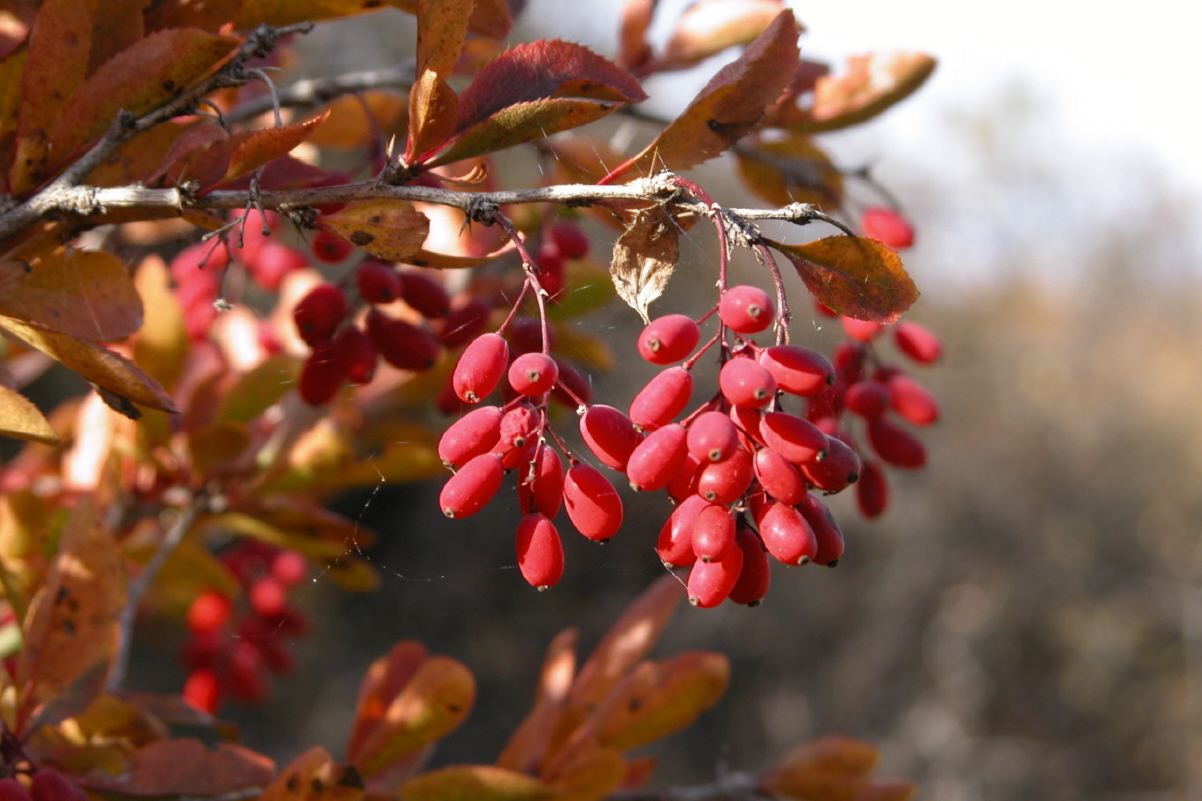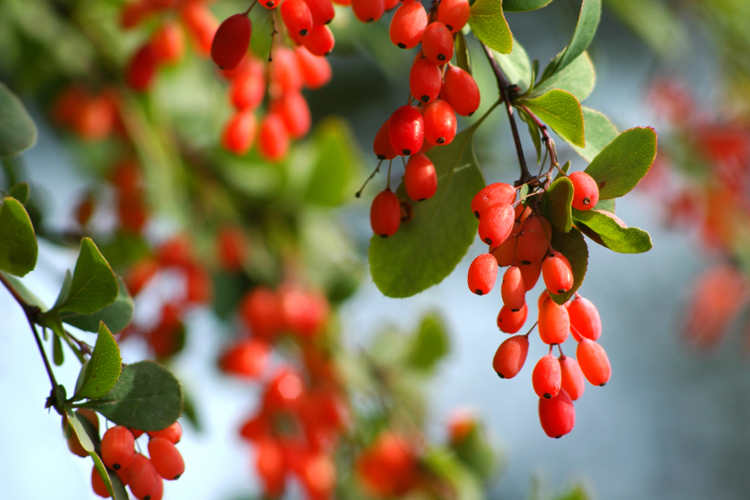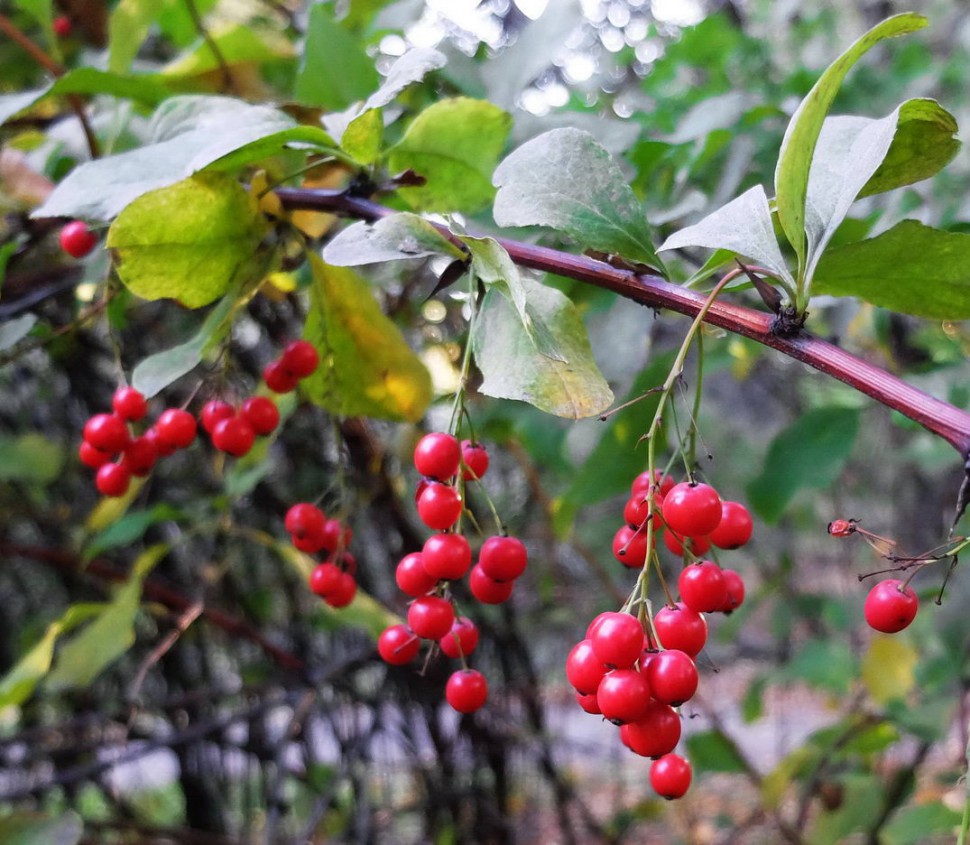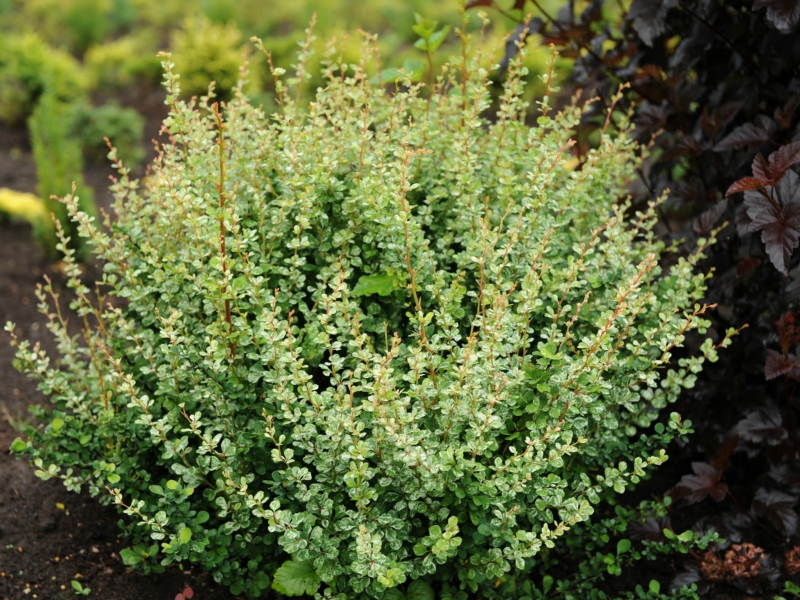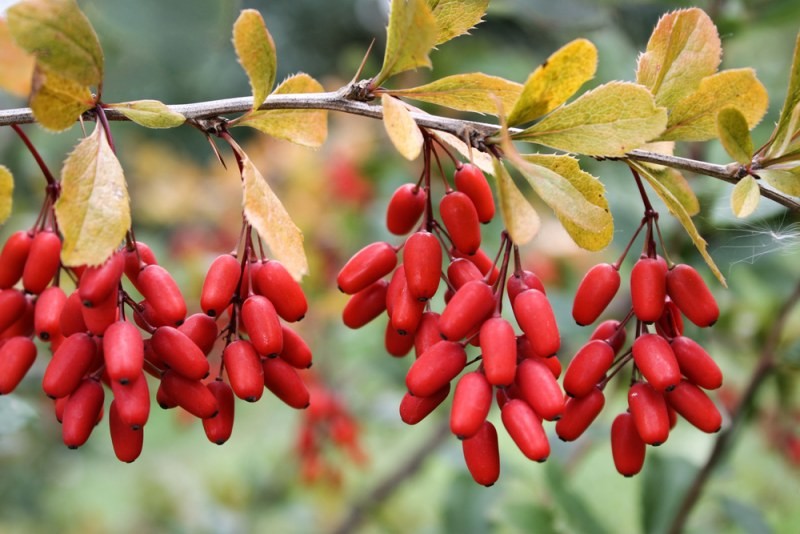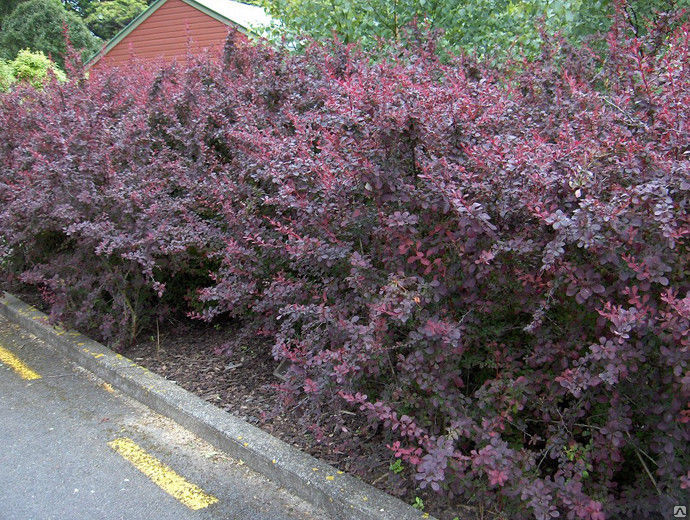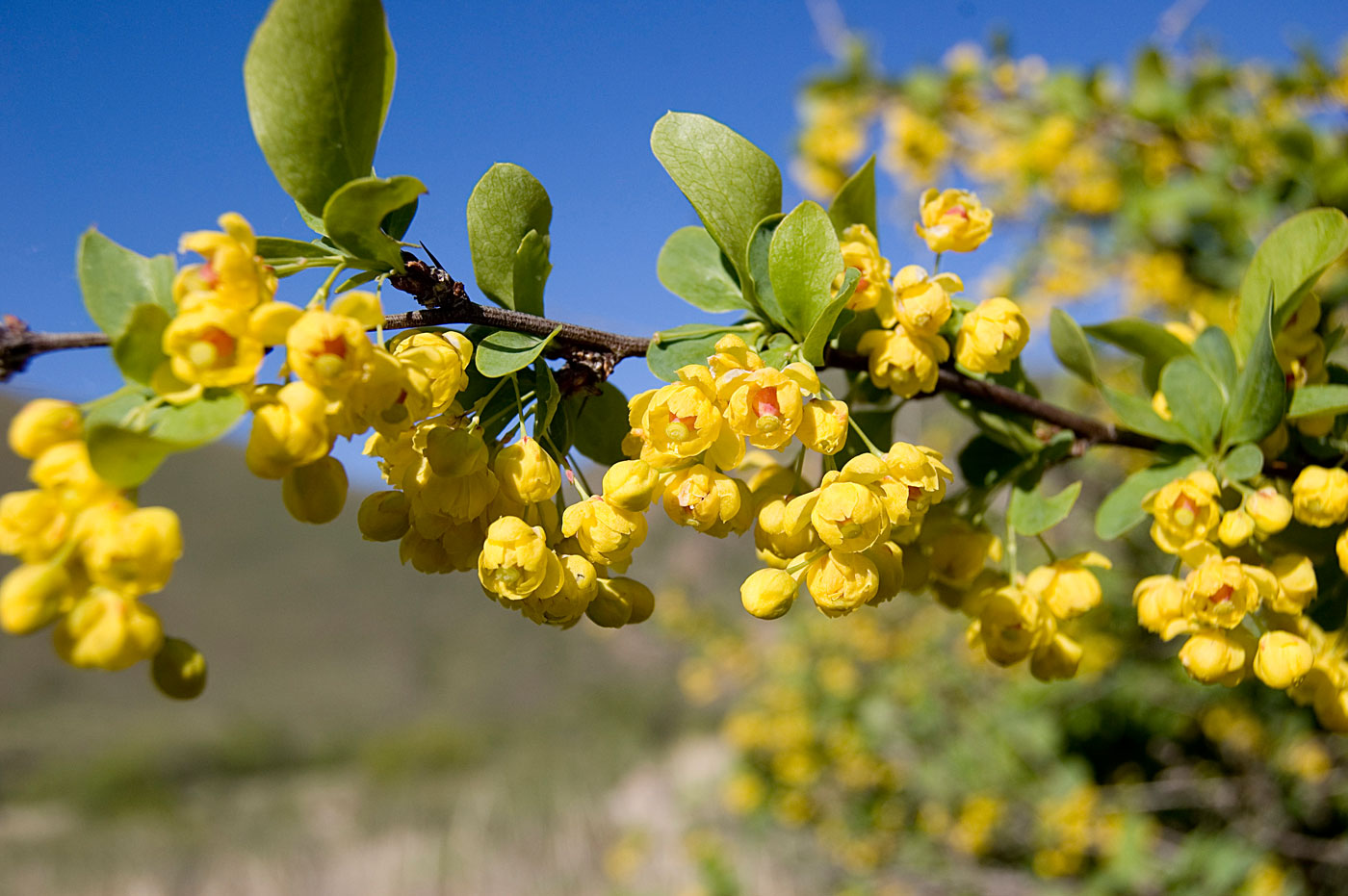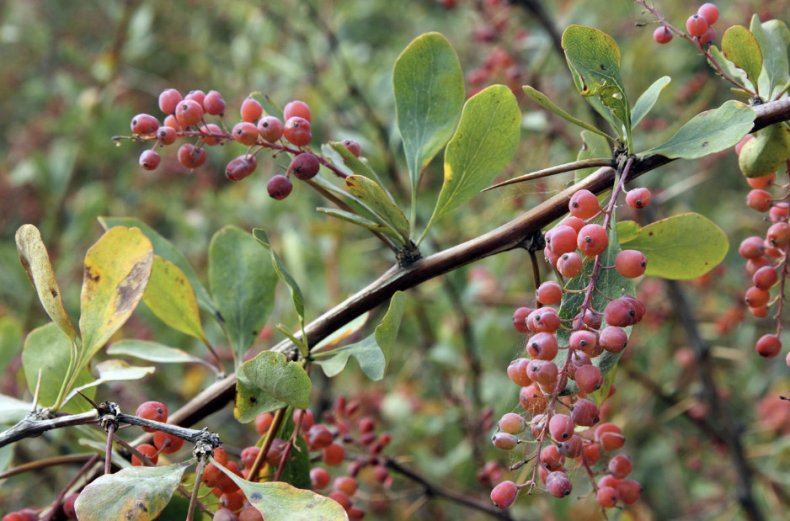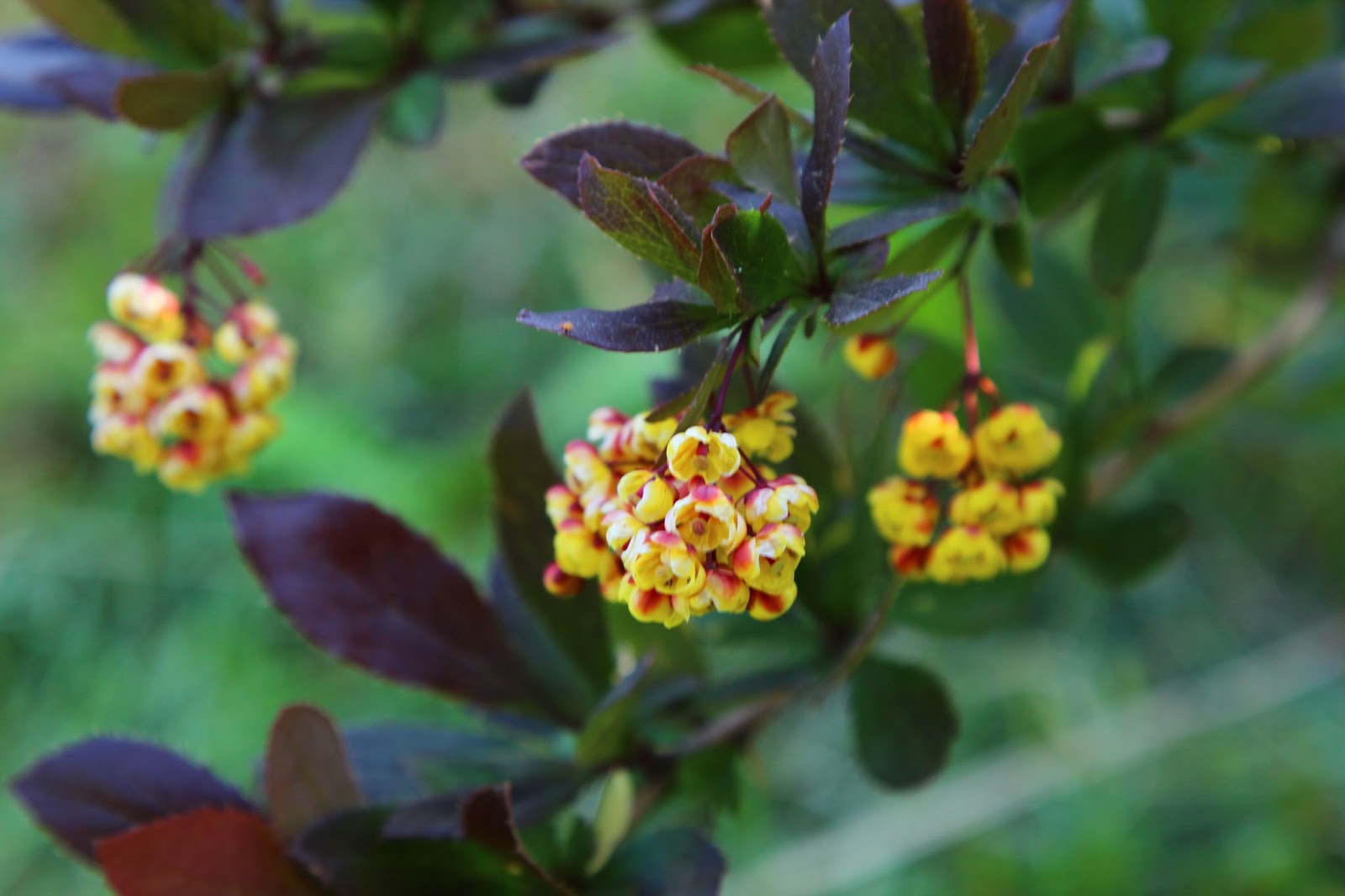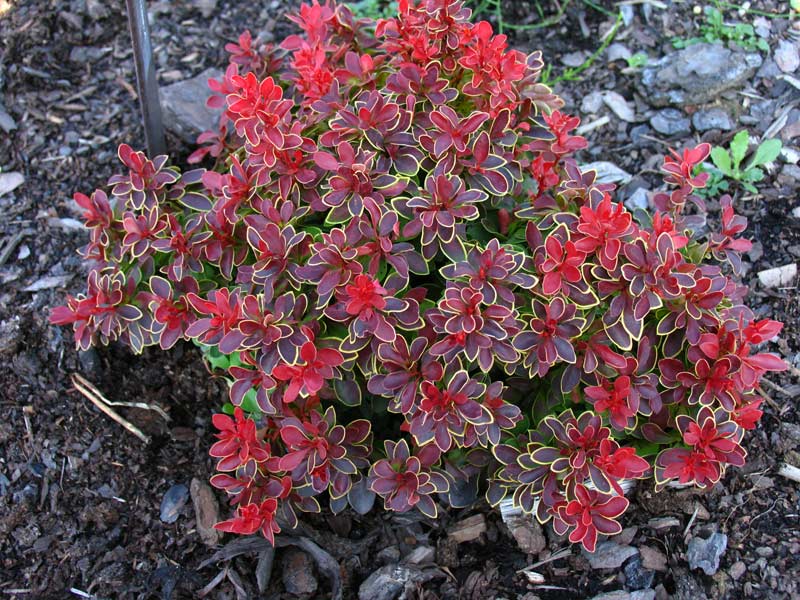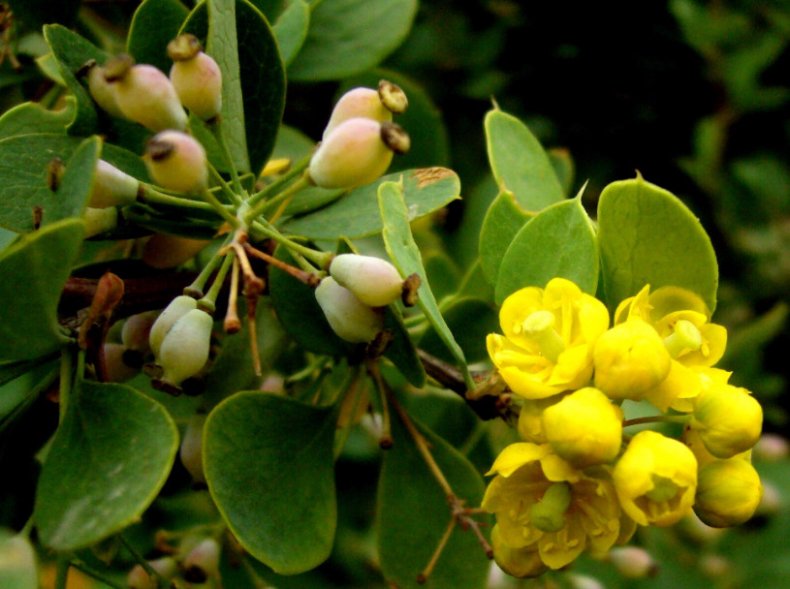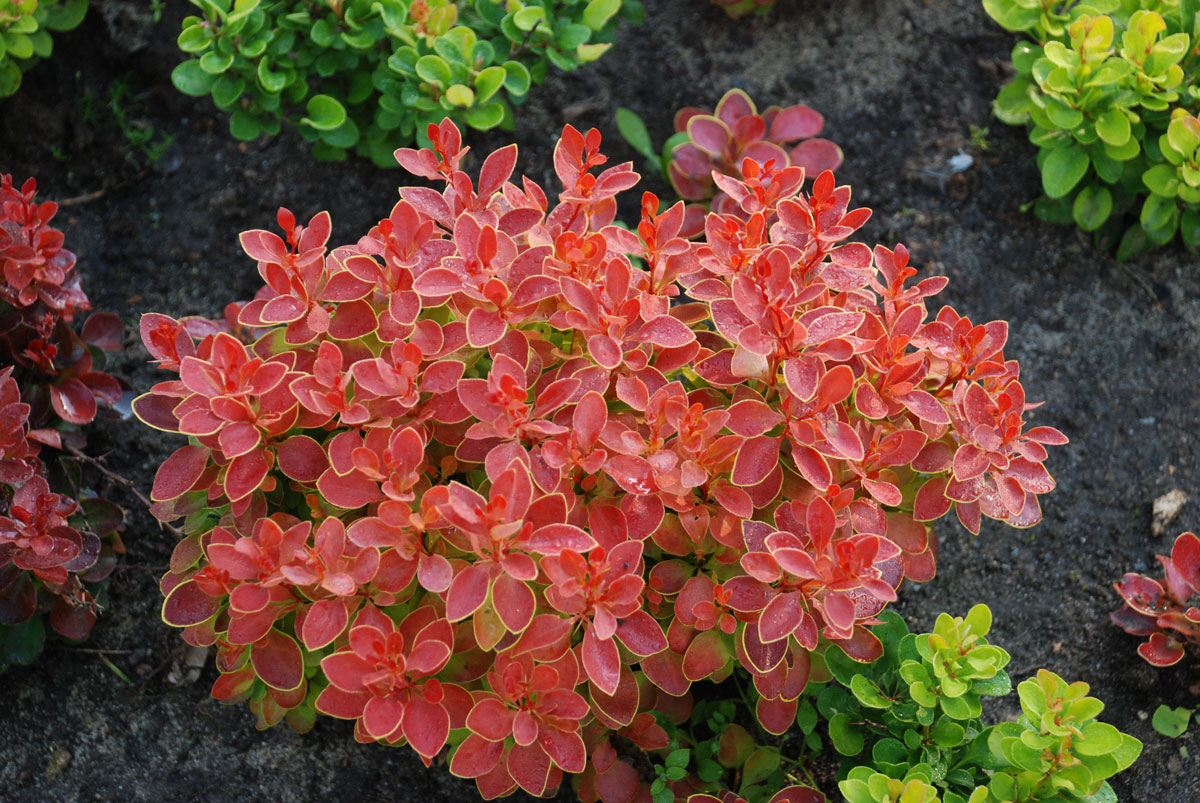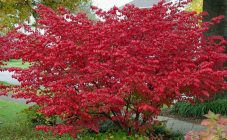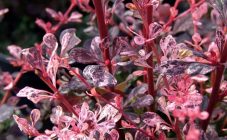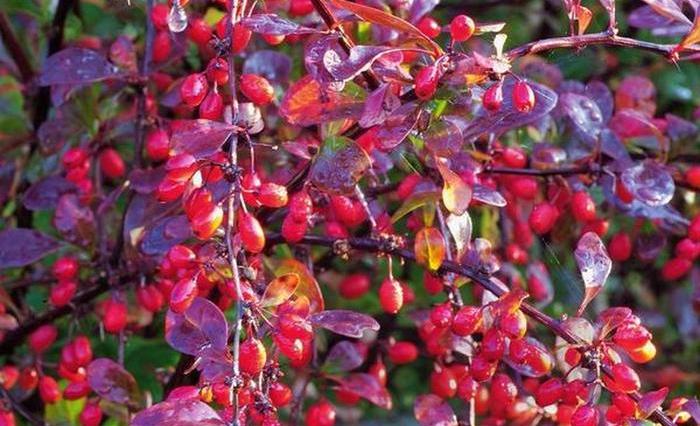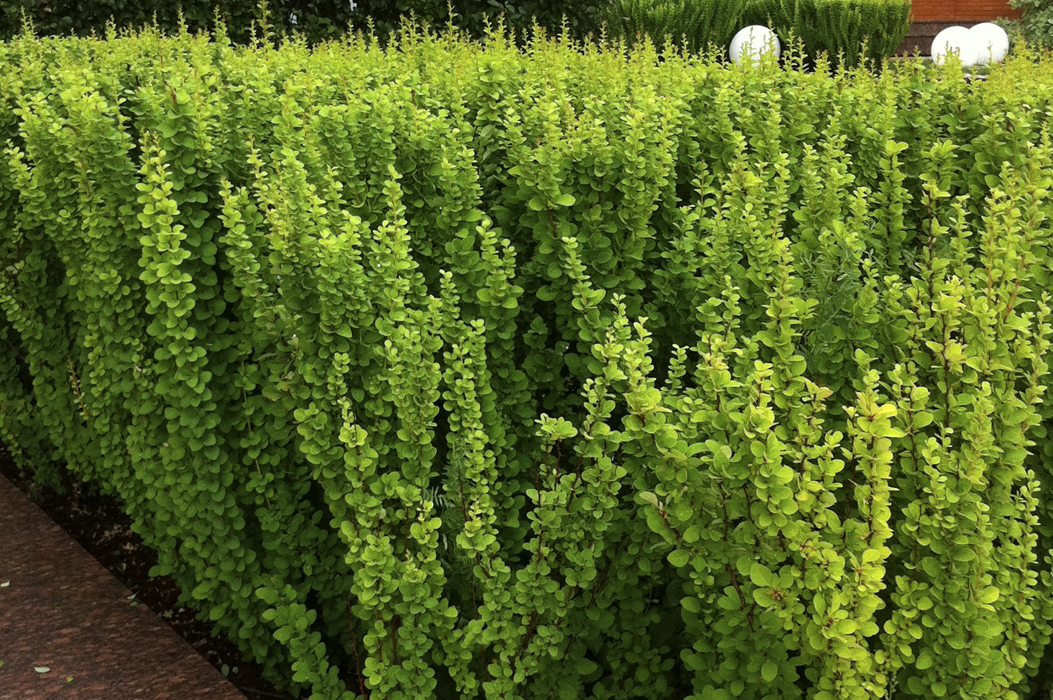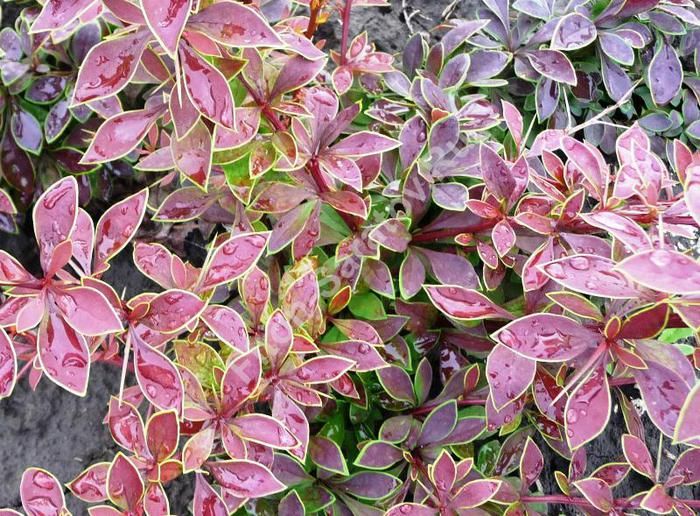Large shrubs (sometimes small trees) belonging to the Barberry family are called barberries. They are distinguished by such a particularly fragrant smell during flowering, lush dense flowers, several prickly shoots. The fruit of the plant is a berry, completely round or ovoid, with an average size of 07-1.3 cm. The plant has found its application in the food, industrial, pharmaceutical industries. Thanks to barberry, it is possible to create a particularly interesting landscape design, diversify your garden.
Popular types and varieties of barberry
Common barberry (Berberis vulgaris)
Many owners are interested in the question of what the common barberry and its varieties are. The first thing to say is that it grows in the form of a bush. Its height is more than 2.5 m. It is distinguished by its thorniness and yellow-brown shoots. The leaves of the plant are dark green in color, and the thorns reach 2 cm in length. In May - July, honey-bearing flowers with a pleasant aroma appear on the bush. You can pick juicy, sour fruits in the fall. True, at this time the leaves themselves are already turning yellow.
The plant does not need special care, it is drought-resistant, but prone to fungal diseases. Its landing does not bring any particular difficulties.
The most famous common varieties are:
- Atropurpurea - grows up to 2 meters, its leaves are purple, and the edible fruit is dark red;
- Macrocarpa - retains all the characteristics of its species, but has large fruits;
- Sulkata - has a particularly sharp ribbed shoots.
Amur barberry (Berberis amurensis)
The description of the plant in the scientific literature makes it clear that it looks very similar to the common barberry. It can grow up to 3.5 m. The leaves of the plant are large (up to 5-8 cm) and have a glossy dark green surface. As with the usual, the thorns can grow up to 2 cm. During the flowering period, the bush is covered with inflorescences with 20-25 flowers. They have a yellowish color and sweet aroma. The fruits grow up to 0.9 cm, in red, they hang on the branches for a long time. Amur barberry is relatively winter-hardy. Grows well in Primorye, found in Japan. Loves mountainous areas and stone ground next to the sea or river.
The most popular varieties:
- Japanese barberry - has wide leaves and lush inflorescences of 6-12 yellow flowers;
- Orpheus is a small bush, has light green leaves and does not bloom.
Korean barberry (Berberis koreana)
As the name suggests, the plant comes from Korea. The bush can grow up to 2 meters high. Leaves are oval, green. Before winter, they get a crimson color. Bright yellow flowers in a brush, 15-20 pieces. They have a strong odor, which makes it possible to quickly identify the plant.
When naming the best barberry and the best varieties for the Moscow region, it is impossible to forget about the Korean variety. It withstands frost well, however, does not like excessive moisture. Prefers stony soils.
All-edge is a varietal representative of the Korean. It is found on the slopes of the mountains, bears fruits in the form of reddish-black berries.
Barberry Thunberg (Berberis thunbergii)
Barberry Thunberg has undersized varieties. These barberry varieties rarely grow taller than one meter. Young shoots are recognized by their yellow color.Subsequently, they darken and turn purplish brown. The leaves are small, but with a light green color and egg-like shape. The plant blooms annually, starting in May or early August. The inflorescences are rich in flowers of red-yellow color. Barberry of the Thunberg variety is prickly. The fruit is not used for consumption as it has a bitter taste.
The list of Thunberg barberry varieties includes more than 70 plants. Most often, Russians prefer these:
- barberry Thunberg Bonanza Gold - a bush with a height of up to 50 cm, distinguished by its golden leaves, blooms every year;
- barberry Thunberg red chief - unlike the previous one, barberry red chief is quite high - up to 2.5 m. Narrow reddish leaves made this plant one of the leaders in landscape design;
- barberry Kornik - is distinguished by an interesting coloring of leaves: a mixture of green and white with a large number of stains. Outwardly, it is very similar to the Tunberg Carmen barberry variety;
- barberry Thunberg Helmond Pillar is a red deciduous variety with a height of 1.3 m. Helmond Pillar reproduces well in the Moscow region;
- barberry Thunberg kelleris is a variegated bush with a height of 1.3 m; changes color of leaves throughout the year: in summer - bright green, in autumn - purple-red;
- Barberry Thunberg dart s red lady - very attractive in appearance: miniature (up to 0.8 m), very bright. Barberry Darts red lady boasts egg-shaped leaves and scarlet color. Barberry Red lady blooms for a relatively long time;
- barberry Atropurpurea Nana - undersized Dutch variety, reaches a maximum height of 0.4-0.6 m; dark purple leaves and reddish-yellow flowers and shiny bright red fruits are the hallmarks of the variety.
This is not a complete list of varieties that this species can boast of. Other varieties widespread in Russia include: goldalita tunberg, tunberg coral, golden carpet, golden dream of tunberg, silver beauty, rocket roses, starburst, powwow, fireball, inspiration, green ornament, chiquita, red carpet, natasha, Evita, ruby star , flamingo, red torch, lutin rouge, florence, orange sunrise, senseishen, concord, indian summer, red dream, chiquita, red dj, fireball, gold fences, kelleris, golden horizon, golden rocket, red pillar, pink queen, golden torch , florence, starburst, red jewel, mix, senseishen, carmen, coral, golden ruby.
Canadian barberry (Berberis canadensis)
It was brought to Russia from North America. Canadian barberry loves the area near rivers, as well as high in the mountains, on the hills. A shrub grows more than 2.5 m in height. It is characterized by brown or dark purple shoots. Outwardly, this barberry species is very similar: ordinary and Amur barberry. Its leaves are green, oblong in shape, reaching 2-5 cm.The plant tolerates drought and frost well. The owners are pleased with the fruits annually.
Ottawa barberry (Berberis x ottawensis)
This variety was successfully bred by crossing the Thunberg barberry and one of the usual varieties. The bush grows up to 2 m and has a dark purple leaf color. This type of plant retains all summer. At the end of May, it begins to bloom. The inflorescences are lush, contain 8-10 flowers.
The bush tolerates pruning, frost, drought well. It can be propagated by seeds or cuttings.
To decorate the territory, the Ottawa barberry of a coma aura is often used. This variety is red-leaved. Visible from afar, because it grows up to 2.5 m and has a bright red leaf color. It turns yellow in the fall.
Ottawa silver miles barberry can be called very original. Its distinctive features:
- height up to 3 m;
- silver pattern on a dark background of leaves;
- yellow flowers;
- red fruits.
Naming the best edible varieties of this barberry, one cannot bypass the Superba variety. It itself has dark red leaves and bright red fruits that ripen in October.
Ball-bearing barberry (Berberis sphaerocarpa)
The mountainous regions of Central Asia remain the homeland of this species. Height (more than 2.5 m) and splendor make it possible to quickly recognize this plant among many others. Unlike other varieties of barberry, the leaves of this species are not bright, but gray-green.Flowers are collected in inflorescences of 5-8 pieces. They have a yellow color and a strong aroma. Sometimes it is also called black barberry, because the plant has a rich dark blue color of wide fruits. Externally, the berries are covered with a bluish bloom. Wide-fruited fruit barberry and its varieties are very popular in countries such as Tajikistan, Kyrgyzstan, Uzbekistan. The berries of the plant are often added to pilaf, compotes, shurpa, and meat dishes.
Barberry mint (Berberis nummularia)
This species comes from Central and Central Asia. Preference is given to dry climates. It differs significantly from others, because with a length of 1.5-2 m it does not stand straight, but curls. The bush has especially long spines - up to 3 cm. Traditionally, for barberry, the monotonous form blooms with yellow flowers, but the leaves are blue-green. The fruits are reddish, with an oval shape. The plant tolerates drought well, but does not tolerate cold. After any damage, it takes a long time to recover.
Siberian barberry (Berberis sibirica)
A low-growing plant, like a barberry, rarely grows higher than 1 m. The shoots of the bush are gray or brown in color. Leaflets are oblong, pointed at the apex.
It begins to bloom in May. The color of the flowers is bright yellow. In diameter, they reach up to 2 cm. The same length of the pedicel. The fruits are oval, red. You can collect them already in September.
A good place for Siberian barberry is rocks, stone soils, mountains, deserts. It can often be found in Mongolia, Altai, in the Sayan Mountains.
Whole-leaf barberry (Berberis integerrima)
The longest of all types of barberry. It can grow up to 4 or even 9 m. The bush curls, and therefore does not take up too much space. The leaves of the plant are completely entire, with a length of up to 5-8 cm. They have a dark blue-green color. With brushes up to 5 cm, inflorescences contain 12-20 flowers.
The berries are purplish red, however, they have a bloom on them. The length of one fruit is 7 to 9 mm. The variety is rich in harvest - there are almost 5 thousand fruits per 1 kg.
Grows in Central Asia, Iran and China. In Russia, this barberry, its types and varieties are popular in the European part.
Turkmen barberry (Berberis turcomanica)
This plant is up to 3 m high. Differs in dense branches and sharp large thorns. The leaves are medium in size and almost never grow more than 4 cm. The gray-green color helps to quickly identify the bush. Sharp liquid teeth at the ends of the plant also contribute to this. This species begins to bloom at the age of 5-6 years. In June, the bush is very densely covered with inflorescences. The length of the brush is 4-6 cm, and the number of flowers is from 15 to 20. Purple-red fruits up to 8 mm long can be harvested in mid-September.
Summing up, we can say that barberry is one of the obligatory shrubs in every garden. The owner will be able to truly appreciate its beauty with the arrival of summer, when the entire bush is covered with lush inflorescences of bright flowers. A pleasant aroma is carried through the garden, beckoning to the bees. The leaves, shoots and roots of the plant are often used in pharmaceuticals, because they contain 11 alkaloids, including: oxycontin, berberine, palmatine.
Thanks to its berries, yellow barberry, varieties of red and black barberry, becomes very useful. They saturate the human body with vitamin K, E, C, pectins, catorite, mineral salts, malic acid.
Low-growing varieties will be an excellent addition for performing interesting landscape design and ennobling a private territory, a park.
